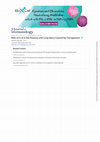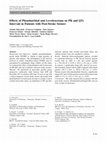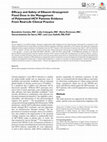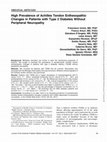Papers by Giovambattista Sarro

Journal of Medicinal Chemistry, 1999
Regioisomeric 3-carboxyisoxazolinyl prolines [CIP-A (+/-)-6 and CIP-B (+/-)-7] and 3-hydroxyisoxa... more Regioisomeric 3-carboxyisoxazolinyl prolines [CIP-A (+/-)-6 and CIP-B (+/-)-7] and 3-hydroxyisoxazolinyl prolines [(+/-)-8 and (+/-)-9] were synthesized and assayed for glutamate receptor activity. The tests were carried out in vitro by means of receptor binding techniques, second messenger assays, and the rat cortical wedge preparation. CIP-A showed a good affinity for both 2-amino-3-(3-hydroxy-5-methylisoxazol-4-yl)propionic acid (AMPA) and kainic acid (KAIN) receptors. These results were confirmed in the cortical slice model where CIP-A displayed an EC(50) value very close to that of AMPA. The convulsant properties of all the compounds were evaluated in vivo on DBA/2 mice after icv injection. CIP-A showed a convulsant activity, measured as tonus and clonus seizures, 18-65 times higher than that produced by AMPA. It was also quite active after ip administration, since it induced seizures in mice at doses as low as 3.2 nmol/mouse. On the basis of the above-reported results we prepared and tested the enantiomers of CIP-A and CIP-B, obtained by reacting (S)-3,4-didehydroproline and (R)-3,4-didehydroproline, respectively, with ethoxycarbonylformonitrile oxide. In all the tests the S-form, CIP-AS [(-)-6], emerged as the eutomer evidencing common stereochemical requirements with the reference compounds AMPA and KAIN. Through modeling studies, carried out on CIP-A, AMPA, and KAIN, active conformations for CIP-AS and AMPA at AMPA receptors as well as for CIP-AS and KAIN at KAIN receptors are suggested.

International Journal of Neuroscience, 1991
Human recombinant interleukin-2 and rat recombinant IL-2 microinjected into the locus coeruleus o... more Human recombinant interleukin-2 and rat recombinant IL-2 microinjected into the locus coeruleus of rats, induced typical dose-dependent behavioural sedation and/or sleep and electrocortical synchronization. During sleep induced by this lymphokine a dose-dependent increase in total voltage power (0.25-16 Hz) as well as in the 0.25-3, 3-6 and 6-9 Hz frequency bands was observed. The behavioural and electrocortical effects of interleukin-2 were blocked in animals pretreated with anti-IL-2 monoclonal antibodies and with naloxone, whereas they were still evident in rats pretreated with yohimbine. In addition, the behavioural and electrocortical slow-wave sleep effects observed after the administration of interleukin-2 into the locus coeruleus were reduced significantly or antagonized completely by a previous pretreatment with pertussis toxin, forskolin, dibutyryl-cyclic-AMP and 8-bromo-cyclic-AMP. These results are consistent with the hypothesis that the behavioural and electrocortical changes of this lymphokine are mediated at locus coeruleus level via a guanine regulatory Gi protein coupling IL-2 specific receptors to the adenylate cyclase system.
Current Vascular Pharmacology, 2016
Current Pharmaceutical Design, 2017

2015 7th International IEEE/EMBS Conference on Neural Engineering (NER), 2015
Hearing loss is one of the most common neural impairments and is usually due to damage to periphe... more Hearing loss is one of the most common neural impairments and is usually due to damage to peripheral structures. The insertion of a specific electronic interface along the auditory pathway, bypassing the area of peripheral damage, can at least partially reactivate the auditory faculty. Herein, a rat brain stimulation technique based on an ultrasound system is presented. The complete system consists of two polyvinylidene-fluoride transducers and an electronic interface, which processes ultrasounds in the air mimicking what happens in the cochlea, simulating action potentials spontaneously generated by the hair cells and then sending them to the brain. The cortical response is closely connected to environmental characteristics carried out by the external stimuli presented to the inferior colliculus, bypassing the sense organ.

Dovepress 1363 R e v I e w open access to scientific and medical research Open Access Full Text A... more Dovepress 1363 R e v I e w open access to scientific and medical research Open Access Full Text Article http://dx.doi.org/10.2147/CIA.S63942 Abstract: The use of atypical antipsychotic drugs in the elderly has become wider and wider in recent years; in fact, these agents have novel receptor binding profiles, good efficacy with regard to negative symptoms, and reduced extrapyramidal symptoms. However, in recent years, the use of both conventional and atypical antipsychotics has been widely debated for concerns about their safety in elderly patients affected with dementia and the possible risks for stroke and sudden death. A MEDLINE search was made using the words elderly, atypical antipsychotics, use, schizophrenia, psychosis, mood disorders, dementia, behavioral disorders, and adverse events. Some personal studies were also considered. This paper reports the receptor binding profiles and the main mechanism of action of these drugs, together with their main use in psychiatry and the ...

Journal of immunology (Baltimore, Md. : 1950), 1999
In the present study we used IL-6 knockout mice (IL-6KO) to evaluate the role of IL-6 in the infl... more In the present study we used IL-6 knockout mice (IL-6KO) to evaluate the role of IL-6 in the inflammatory response caused by injection of carrageenan into the pleural space. Compared with carrageenan-treated IL-6 wild-type (IL-6WT) mice, carrageenan-treated IL-6KO mice exhibited a reduced degree of pleural exudation and polymorphonuclear cell migration. Lung myeloperoxidase activity and lipid peroxidation were significantly reduced in IL-6KO mice compared with those in IL-6WT mice treated with carrageenan. Immunohistochemical analysis for nitrotyrosine and poly(A)DP-ribose polymerase revealed a positive staining in lungs from carrageenan-treated IL-6WT mice. No positive staining for nitrotyrosine or PARS was found in the lungs of the carrageenan-treated IL-6KO mice. Staining of lung tissue sections obtained from carrageenan-treated IL-6WT mice with an anti-cyclo-oxygenase-2 Ab showed a diffuse staining of the inflamed tissue. Furthermore, expression of inducible nitric oxide synthas...

Clinical drug investigation, 2014
Sudden unexplained/unexpected death (SUDEP) is related to high mortality in patients with epileps... more Sudden unexplained/unexpected death (SUDEP) is related to high mortality in patients with epilepsy. The prolongation of QT interval, involved in cardiac arrhythmia-related SUDEP, may be precipitated by antiepileptic drugs (AEDs). In this study, we evaluated the effects of phenobarbital and levetiracetam on PR-QTc intervals in patients with post-stroke seizures. We performed an open-label, parallel group, prospective, multicenter study between June 2009 and December 2013 in patients older than 18 years of age with a clinical diagnosis of post-stroke seizure and treated with phenobarbital or levetiracetam. In order to exclude a role of cerebral post-stroke injury on modulation of PR and QTc intervals, patients with cerebral post-stroke injury and without seizures were also enrolled as controls. Interictal electrocardiography analysis revealed no significant difference in PR interval between patients treated with an AED (n = 49) and control patients (n = 50) (181.25 ± 12.05 vs. 182.4 ±...

Updates in Surgery, 2012
Literature data indicate that mast cells (MCs) are involved in angiogenesis through the release o... more Literature data indicate that mast cells (MCs) are involved in angiogenesis through the release of several pro-angiogenetic factors among which tryptase, a serine protease stored in MC granules, is one of the most active. However, no data are available concerning the role of MCs during keloids' angiogenesis. In this study, we evaluated the correlations of the number of MCs positive to tryptase (MCDPT) and microvascular density (MVD) within a series of 15 keloids and 10 normotrophic scars, by means of immunohistochemistry and image analysis methods. Data demonstrated a significant difference of MVD and MCDPT between keloids and normotrophic scars and a significant correlation between MVD and MCDPT in keloids. Our results suggest that tryptase-positive MCs might play a key role in keloids' angiogenesis. In this context, several tryptase inhibitors might be clinically evaluated as a possible new anti-angiogenetic approach to prevent keloid formation after surgery.

Journal of Pharmaceutical and Biomedical Analysis, 2004
A high-performance liquid chromatography (HPLC)-method after solid-phase extraction (SPE) has bee... more A high-performance liquid chromatography (HPLC)-method after solid-phase extraction (SPE) has been developed in order to determine a new angiotensin-AT1 antagonist, i.e. CR 3210 (C27H24N8; MW = 460.54), 4-[4-[(2-ethyl-5,7-dimethylimidazo[4,5-b]pyridin-3-yl)methyl]phenyl]-3-(2H-tetrazol-5-yl)quinoline in rat plasma and urine after oral administration to Sprague-Dawley rats. CR 3210 and the internal standard (IS) CR 1505 (loxiglumide), i.e. 4-[(3,4-dichlorobenzoyl)amino]-5-[(3-methoxypropyl)pentylamino]-5-oxopentanoic acid, were isolated from rat urine and plasma by solid-phase extraction. The procedure was optimized regarding the sorbent extraction material, the pH in the conditioning solution, the washing step, the dry time and the type of elution solvent. The separation was performed by reversed-phase high-performance liquid chromatography with ultraviolet detection. The samples were injected onto the analytical column (Tracer Extrasil ODS1) and detected at 238 nm, giving a capacity factor of 1.87 for CR 3210 and 1.10 for the internal standard. The selectivity of the method was satisfactory. The mean recovery of CR 3210 from spiked rat plasma was 68.5 at 75 ng/ml and 80.9 at 3000 ng/ml; the mean recovery of CR 3210 from spiked rat urine was 69.9 at 75 ng/ml and 78.6 at 3000 ng/ml. The lower limit of detection (LOD) was 14 ng/ml in plasma and 22 ng/ml in urine samples. The lower limit of quantification (LOQ) was taken as 30 ng/ml, the lowest calibration standard using 500 microl rat plasma and urine. The procedures were validated according to international standards with a good reproducibility and linear response from 30 to 3000 ng/ml, for either plasma or urine. The sensitivity of the method allowed for its application to pharmacokinetic studies.
Journal of Medicinal Chemistry, 1998
European Journal of Pharmacology, 1986
... brain region in the propagation of seizure activity in many animal models of epilepsy (De Sar... more ... brain region in the propagation of seizure activity in many animal models of epilepsy (De Sarro et al., 1984; Iadarola and Gale, 1982; McNamara ... areas of the brain and recently this nucleus was shown to be critally involved in the propagation of limbic seizure activity (Patel et al ...

European Journal of Pharmacology, 2003
Metabotropic glutamate (mGlu) receptors have multiple actions on neuronal excitability through G-... more Metabotropic glutamate (mGlu) receptors have multiple actions on neuronal excitability through G-protein-linked modifications of enzymes and ion channels. They act presynaptically to modify glutamatergic and gamma-aminobutyric acid (GABA)-ergic transmission and can contribute to long-term changes in synaptic function. The recent identification of subtype-selective agonists and antagonists has permitted evaluation of mGlu receptors as potential targets in the treatment of epilepsy. Agonists acting on group I mGlu receptors (mGlu1 and mGlu5) are convulsant. Antagonists acting on mGlu1 or mGlu5 receptors are anticonvulsant against 3,5-dihydroxyphenylglycine (DHPG)-induced seizures and in mouse models of generalized motor seizures and absence seizures. The competitive, phenylglycine mGlu1/5 receptor antagonists generally require intracerebroventricular administration for potent anticonvulsant efficacy but noncompetitive antagonists, e.g., (3aS,6aS)-6a-naphthalen-2-ylmethyl-5-methyliden-hexahydrocyclopenta[c]furan-1-on (BAY36-7620), 2-methyl-6-(phenylethynyl)pyridine hydrochloride (MPEP), and 2-methyl-6-(2-phenylethenyl)pyridine (SIB-1893) block generalized seizures with systemic administration. Agonists acting on group II mGlu receptors (mGlu2, mGlu3) to reduce glutamate release are anticonvulsant, e.g., 2R,4R-aminopyrrolidine-2,4-dicarboxylate [(2R,4R)-APDC], (+)-2-aminobicyclo[3.1.0]hexane-2,6-dicarboxylic acid (LY354740), and (-)-2-oxa-4-aminobicyclo[3.1.0]hexane-4,6-dicarboxylate (LY379268). The classical agonists acting on group III mGlu receptors such as L-(+)-2-amino-4-phosphonobutyric acid, and L-serine-O-phosphate are acutely proconvulsant with some anticonvulsant activity. The more recently identified agonists (R,S)-4-phosphonophenylglycine [(R,S)-PPG] and (S)-3,4-dicarboxyphenylglycine [(S)-3,4-DCPG] and (1S,3R,4S)-1-aminocyclopentane-1,2,4-tricarboxylic acid [ACPT-1] are all anticonvulsant without proconvulsant effects. Studies in animal models of kindling reveal some efficacy of mGlu receptor ligands against fully kindled limbic seizures. In genetic mouse models, mGlu1/5 antagonists and mGlu2/3 agonists are effective against absence seizures. Thus, antagonists at group I mGlu receptors and agonists at groups II and III mGlu receptors are potential antiepileptic agents, but their clinical usefulness will depend on their acute and chronic side effects. Potential also exists for combining mGlu receptor ligands with other glutamatergic and non-glutamatergic agents to produce an enhanced anticonvulsant effect. This review also discusses what is known about mGlu receptor expression and function in rodent epilepsy models and human epileptic conditions.

European Journal of Pharmacology, 2002
We report the anticonvulsant action in DBA/2 mice of two mGlu Group III receptor agonists: (R,S)-... more We report the anticonvulsant action in DBA/2 mice of two mGlu Group III receptor agonists: (R,S)-4-phosphonophenylglycine, (R,S)-PPG, a compound with moderate mGlu8 selectivity, and of (1S,3R,4S)-1-aminocyclopentane-1,2,4-tricarboxylic acid, ACPT-1, a selective agonist for mGlu4alpha receptors. Both compounds, given intracerebroventricularly at doses which did not show marked anticonvulsant activity, produced a consistent shift to the left of the dose-response curves (i.e. enhanced the anticonvulsant properties) of 1-(4'-aminophenyl)-3,5-dihydro-7,8-dimethoxy-4H-2,3-benzodiazepin-4-one hydrochloride, CFM-2, a noncompetitive AMPA receptor antagonist, and 3-((+/-)-2-carboxypiperazin-4-yl)-1-phosphonic acid, CPPene, a competitive NMDA receptor antagonist, in DBA/2 mice. In addition, (R,S)-PPG and ACPT-1 administered intracerebroventricularly prolonged the time course of the anticonvulsant properties of CFM-2 (33 micromol/kg, i.p.) and CPPene (3.3 micromol/kg, i.p.) administered intraperitoneally. We conclude that modest reduction of synaptic glutamate release by activation of Group III metabotropic receptors potentiates the anticonvulsant effect of AMPA and NMDA receptor blockade.

Annals of Pharmacotherapy, 2004
between administration of modified-release clarithromycin and the development of pancreatitis is ... more between administration of modified-release clarithromycin and the development of pancreatitis is clear. Case Report. A 43-year-old man presented with abdominal pain. His medical history included a perforated tympanum with episodes of acute otitis media. There was no history of alcohol or narcotic ingestion, and there was no other illness. There also was no history of pancreatic disease. The pain had begun 20 minutes after the patient took clarithromycin 500 mg in the form of modified-release tablets after the onset of otic infection; however, he did not come to the hospital until 48 hours after onset. Laboratory test results showed total leukocyte value 14.8 × 103/mm3, amylase level 198 IU/mL (range 0–100), lactate dehydrogenase 727 IU/mL (260–450), and C-reactive protein 18.5. Tests of hepatic function were normal. The ultrasound did not reveal gallstones, and the axial abdominal tomographic scan showed inflammatory changes in the peripancreatic fat and pancreatic fluid in the left pararenal anterior space which spread toward the left gutter with partial necrosis (<30%). The magnetic resonance cholangiography was normal. The patient was discharged after 10 days. Given the clear causal link between the appearance of pancreatitis and the ingestion of the drug and the normal values obtained in hepatic function tests, it was considered unnecessary to carry out an endoscopic retrograde cholangiopancreatography. Discussion. Erythromycin is considered to be a motiline agonist of the smooth gastrointestinal musculature with a proven prokinetic action. The drug also acts as a stimulant in the sphincter of Oddi, provoking possible secondary biliary reflux toward the pancreatic duct, thus triggering the inflammatory cascade of acute pancreatitis.2 However, this mechanism was not corroborated after the discovery by Wehrmann et al.3 of the existence of a decrease in both the base pressure of the sphincter of Oddi and the frequency of phasic contractions in humans with the use of erythromycin. However, investigators also demonstrated that the administration of erythromycin produces an increase in the average duration of the phasic contractions of the sphincter, as well as in their amplitude. Clarithromycin, as a macrolide, also has a prokinetic effect similar to that of erythromycin, although of a shorter duration, on the gallbladder and in the gastric antrum. There is no reliable hypothesis regarding clarithromycin’s mechanism of action on the biliopancreatic sphincter.4 Clarithromycin is widely used in our environment and is responsible for a considerable incidence of gastrointestinal secondary effects, among which the appearance of acute pancreatitis is exceptional. Use of the Naranjo probability scale indicates a probable relationship between acute pancreatitis and modified-release clarithromycin.5

General Pharmacology: The Vascular System, 1997
1. The effects of the ACE inhibitor enalapril were studied in rats with cardiac hypertrophy induc... more 1. The effects of the ACE inhibitor enalapril were studied in rats with cardiac hypertrophy induced by abdominal aortic constriction. This experimental model has shown that pump failure can be evidenced only during increased workload. 2. Under basal conditions, enalapril at 1-3 mg/kg induced a significant reduction in blood pressure. During the acute volume loading or the increase in afterload due to a total aortic occlusion, only rats treated with 3 mg/kg enalapril, but not 1 mg/kg, received a hemodynamic benefit that was paralleled by a significant reduction in cardiac hypertrophy. 3. The present study demonstrates that reduction in blood pressure on its own was not sufficient to improve cardiac function. A decrease in blood pressure accompanied with hypetrophy regression were necessary to normalize hemodynamic parameters in pressure-overloaded rats.

Journal of clinical pharmacology, Jan 10, 2018
Chronic hepatitis C virus (HCV) infection represents a global public health challenge, and new dr... more Chronic hepatitis C virus (HCV) infection represents a global public health challenge, and new drugs have been authorized for its treatment. In this study, we evaluated both the clinical efficacy and safety of elbasvir-grazoprevir fixed-dose combination in HCV patients. We performed a prospective single-blind study on patients admitted to the Regional Center for HCV Treatment of the University of Catanzaro from March 1, 2017, to December 31, 2017, in patients >30 years old with a history of chronic HCV infection. During the study period, we enrolled 29 HCV patients (18 women and 11 men; age, 62.5 ± 14 years, range 36-82; HCV-RNA: 2 384 859 ± 2 487 747 IU/mL, range, 60 400 - 8 930 000 IU/mL genotype 1b). In 28 of 29 patients (96.5%) we documented a rapid and complete remission of HCV infection 4 weeks after the beginning of the treatment, while in 1 patient it was reached in 8 weeks. During the study, we did not record any serious adverse drug reaction or drug interaction and no p...

Journal of the American Podiatric Medical Association, Jan 10, 2016
Metabolic disorders are known to alter the mechanical properties of tendons. We sought to evaluat... more Metabolic disorders are known to alter the mechanical properties of tendons. We sought to evaluate the prevalence of asymptomatic Achilles tendon enthesopathic changes in patients with type 2 diabetes mellitus (T2DM) without peripheral neuropathy. We recruited 43 patients with T2DM and 40 controls. Neuropathy was excluded with the Michigan Neuropathy Scoring Instrument. Bilateral ultrasonography of the Achilles tendon enthesis was performed. Patients with T2DM had a higher prevalence of hypoechogenicity (26.7% versus 2.5%; P = .0001), entheseal thickening (24.4% versus 8.7%; P = .007), and enthesophytes (74.4% versus 57.5%; P = .02). No differences were found in the number of patients with erosions (1.2% versus 0%; P > .99), cortical irregularities (11.6% versus 3.7%; P = .09), bursitis (5.8% versus 3.7%; P = .72), or tears (2.3% versus 1.2%; P > .99). The mean ± SD sum of abnormalities was higher in patients with T2DM (1.5 ± 1.1 versus 0.7 ± 0.6; P < .0001), as was the per...








Uploads
Papers by Giovambattista Sarro